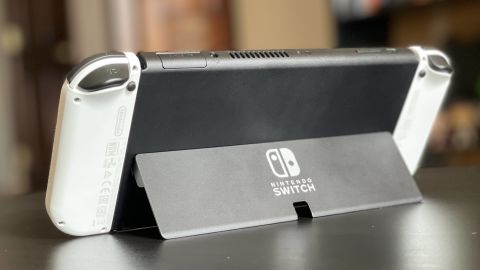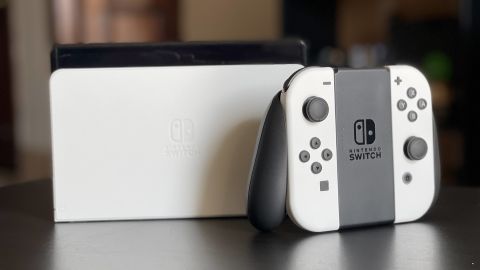CNN
—
At first glance, the Nintendo Switch OLED seems like a nice but inessential upgrade that gives Nintendo’s popular console a bigger, bolder screen. But now that I’ve got my hands on one, I’m taking every opportunity I can to play games on it — and I’m not sure I can go back to my regular Switch.
The Nintendo Switch OLED is the obvious Switch to get for first-time buyers, combining a gorgeous 7-inch handheld display with some smart design changes that make the console more comfortable and versatile. But is it worth the upgrade if you already own a Switch or Switch Lite? Here’s what I think after spending many, many hours playing games on Nintendo’s new hardware.
The Nintendo Switch OLED sports a gorgeous 7-inch OLED screen in addition to a number of design improvements, but not everyone needs to upgrade.
The who, what and how
Who it’s for: The $349 Nintendo Switch OLED is the model to get for first-time Switch buyers, or anyone willing to upgrade for the biggest, most colorful display available in Nintendo’s console lineup.
What you need to know: As its name suggests, the Nintendo Switch OLED introduces an immersive 7-inch OLED screen that makes games look much more vibrant when playing in handheld or tabletop mode. You’ll also get an improved kickstand and a sleeker-looking dock with a built-in Ethernet port for more solid online play.
How it compares: The Switch OLED has the biggest and best display of the Switch lineup, with a 7-inch OLED screen that trumps the 6.2-inch Nintendo Switch and the 5.5-inch Switch Lite, both of which have less vibrant LCD displays. It also has twice the internal storage of other Switch consoles at 64GB. But it’s got the same processor and display resolution as previous models, meaning you won’t see games perform better or look sharper on a TV on the OLED version. If you can live without OLED and want the cheapest and most portable member of the Switch family, the handheld-only $199 Nintendo Switch Lite is still a great buy.
The OLED screen makes a big difference

The Nintendo Switch OLED’s new display is a pretty dramatic upgrade from the original model’s — and not just because the colors are prettier. The new system bumps the display size from 6.2 inches to 7 inches while keeping the console’s dimensions roughly the same, resulting in a screen that’s both richer and more immersive. But let’s talk OLED first.
For the uninitiated, OLED is a display technology that’s built to deliver bolder colors, stronger brightness and sharper contrast than what you’ll get on a standard LCD screen. And similar to what we’ve experienced on some of our favorite TVs and laptops, the Switch OLED’s screen adds a significant layer of visual pop that makes some of the best Switch games look even better.

From the second I booted up the Switch OLED and put it next to my regular Switch, I immediately noticed a big difference. Even the home screen looks nicer on Nintendo’s new console, with a deeper shade of gray in the background, bigger and bolder text and a more vibrant row of game icons that were just begging me to play them. So I did — and was treated to some pretty great results.
The Switch OLED made just about every game I threw at it look better than usual, but there were some notable standouts. When running and gunning in Metroid Dread, I noticed some especially rich reds and blues on Samus’ suit, and stopped to take in the game’s colorful, moody sci-fi backgrounds on more than one occasion. A sea of satisfying neon lights beamed out of the screen when I drove through a busy metropolis in Cruis’n Blast, and the hand-drawn fantasy worlds of Hades — a game I’ve poured dozens of hours into on multiple platforms — looked more vibrant than I’ve ever seen them.

But no game quite showed off the Switch OLED’s prowess quite like Tetris Effect Connected, a trippy take on the classic puzzle game that constantly throws striking new visual themes at you. The game’s colorfully animated puzzle blocks contrasted beautifully with its deep black backgrounds on the new Switch’s screen, adding a level of eye-popping immersion that made this already stunning title hard to take my eyes off of.
It’s not just the addition of OLED that makes the new Switch’s screen so great — the larger 7-inch canvas is just as significant. With more screen space and much slimmer bezels surrounding the display, it was a lot easier to get lost in an ethereal Tetris Effect level, or keep track of the many demonic enemies trying to kill me in Hades.
Once I picked up my original Switch after spending significant time with the OLED, the old display looked tiny and kind of dull by comparison. The OLED model won’t make your games look significantly sharper or more detailed — it’s got the same 720p display resolution as the Switch and Switch Lite — but its bigger screen size and gorgeous color quality make it very hard to go back.
Related: Which Nintendo Switch should you buy?
A refined design with some useful features

Shiny new OLED screen aside, the Nintendo Switch OLED is simply a sleeker and slightly more versatile piece of hardware. The power and volume buttons are wider and more distinct from one another, and the fan vents up top are thinner and less distracting. The entire tablet portion of the console has a matte finish, which both feels nicer to grip and is far less prone to fingerprint smudges (seriously, you don’t want to see the back of my OG Switch). But the biggest upgrade to the Switch OLED’s physical design is its much-improved kickstand.
The original Switch has a flimsy, inch-wide kickstand that’s prone to popping out and doesn’t do a great job supporting the console in tabletop mode, which is why Nintendo replaced it with a new adjustable stand that spans the entire rear of the console. On top of feeling much sturdier and less wobble-prone than the previous stand, this new version also allows you to prop the Switch up at multiple angles. which I found handy for finding the perfect view while getting beat up in Nickelodeon All-Star Brawl on my coffee table.
The new console also features what Nintendo is calling “enhanced audio,” but while everything from the sounds of shooting aliens in Metroid Dread to the pulsing beats of Tetris Effect sounded great, I can’t say I noticed a significant bump in volume or audio quality compared to my old Switch. You’re still better off pairing your own Bluetooth headphones for the best possible sound.

The Switch OLED ups the system’s internal storage from 32GB to 64GB, giving you twice the amount of free space for game downloads and screenshots. It’s a welcome upgrade, but I still found myself filling the console up after downloading eight or so titles, and would still recommend that any Switch owner gets at least a 128GB microSD card for their system.
Lastly, I’d be remiss not to talk about the gorgeous new white Joy-Cons that my review unit came in. They’re functionally the same as previous Joy-Cons (and unfortunately aren’t sold separately for current Switch owners), but they combine nicely with the bezel-less screen and refined design to make the Switch OLED feel less like a toy and more like a modern piece of tech.
A mostly improved dock with the same old specs

The Nintendo Switch OLED also comes with an overhauled dock, which you’ll use to charge the system and play it on your TV. It won’t make your games look or run any better than the previous Switch dock, but it’s sleeker than before, has some useful upgrades and looks especially stunning in white — though it does have some drawbacks.
The new dock now has a built-in Ethernet port, allowing you to enjoy a wired internet connection for faster downloads and more solid online play without the need for an adapter. It’s a useful addition, and one that I appreciate as someone who plays lots of competitive games online, but it does replace the additional USB port that’s found on the classic Switch dock. This might not be a huge deal to most players, but folks who use lots of third-party accessories (like controllers and headsets) should keep in mind that the new dock has only two USB ports instead of three.
The dock’s rear panel now pops off completely rather than being attached by a hinge — this makes it a little easier to access the various ports in the back, but also introduces a removable part that could get lost (especially if you have little ones around). And even with this change, I still found things to feel a bit cramped in the back when plugging the power, HDMI and Ethernet cables in.
The Switch OLED dock is also more spacious — perhaps too spacious — when it comes to actually docking the system. While the added breathing room seems like it could prevent the screen from getting scratched, it also causes the Switch to wobble a bit when docked, which makes me worry slightly about its long-term durability.
It’s worth noting that while the Switch OLED’s dock has been refined a bit, the experience of playing games on your TV is exactly the same as it was on the previous system. The system is powered by the same processor as before, and here are no big performance upgrades — your games will still run at 1080p on a television, and you won’t see any improvements to things like textures and load times. Alas, my dream of a Nintendo Switch that loads games as fast as my Xbox Series S or PlayStation 5 continues to be just that.
Solid battery life — but not the best
The Switch OLED is on the higher end of the Switch lineup when it comes to battery life, though you’ll want to keep a portable charger handy if you’re playing demanding games like Breath of the Wild for long stretches of time.
To see how long Nintendo’s new console could survive an extended gaming session, we fired up Super Smash Bros. Ultimate and ran an endless eight-character battle with brightness set to max and all items turned on for maximum chaos. The Switch OLED lasted for four hours and 16 minutes — that’s better than what we got from the Nintendo Switch Lite (3:50) and the launch Nintendo Switch (2:45), but not quite as good as the 4:50 we got from the refreshed Nintendo Switch model from 2019.
Our Switch OLED runtime is a bit behind Nintendo’s estimate of four and a half to nine hours, which is the same rating that the 2019 Switch carries. We’ve seen some OLED devices drain battery faster than their non-OLED counterparts, which could be the case here. Still, you’ll enjoy a pretty significant battery bump if you’re upgrading from a launch Switch, and will get a bit of extra juice if you’re coming from a Switch Lite.
Bottom line

The Nintendo Switch OLED is the best version of Nintendo’s current console yet, with a beautiful and big display for playing games in handheld mode, a great kickstand for tabletop play and a sleek dock for connecting to your TV. If you don’t already own a Nintendo Switch, this is the one to get.
As for everyone else? If you already own the standard Switch and mostly play games on your TV, the Switch OLED won’t do anything new for you. It also has the same core performance as previous consoles, so don’t expect better graphics or load times. For those who use handheld or tabletop mode a decent amount, you’re getting a much better screen, a handy kickstand and — if you’re coming from the launch Nintendo Switch — a decent battery life bump. Those upgrades might not be worth the steep price for everyone, but as a Switch owner who spends a good chunk of their game time in handheld mode, I’m having a very hard time going back after living with the OLED for a few days.
If you’re like me and are considering making the jump to OLED, you can always trade in your existing Switch to make that price tag sting a little less. GameStop is currently offering up to $220 in store credit for the standard Switch, while trade-in site Decluttr will give you $150, to name just a few examples. If you go the Decluttr route, you can get up to $30 extra in trade-in value by using our code “CNN2021” at checkout through the end of the month.
It’s also worth mentioning that the Nintendo Switch OLED is pretty hard to find right now, and like those seeking PS5 restocks and Xbox Series X restocks, you’ll have to check your favorite retailers often for a chance to buy one. But if you’re getting your first Switch — or are willing to upgrade for the best screen on a Nintendo console yet — it’s worth taking the time to hunt one down.



